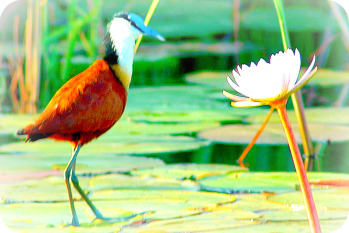UGANDA BIRDING SAFARI GUIDE
The African Jacana
Are you Planning a Uganda Birding Safari...? Then get ready to find the African Jacana.
The information about African Jacanas in this section of the Uganda Birding Safari guide will help get the most out of your Bird watching tour to Africa.
You will find tips and info about:
- Where to find the African Jacana in Uganda
- How to Identify them and
- Some interesting facts about these Uganda birds
Where to find the African Jacana (Actophilornis africanus)
Jacanas are also known as “lily- trotters” because of their striking long legs & long toes which enable them to walk on their splayed feet across floating vegetation especially water lilies while feeding on them.
The African jacana is unusual with a chestnut torso.
While in Uganda you will be able to find these birds common in almost all wetlands in the country, they are common residents of fresh water lakes & ponds at an altitude of 3000 m above sea level.
Therefore if you take a trip along Lake Victoria, Lake Albert or Lake Edward you will come across the African jacana.
Characteristics of the African Jacana
The adult bird is 32 cm in height. Sexes are similar but the female bird is slightly larger than the male.
They are unusual among birds in that the female birds display secondary sex characteristics.
The adult bird is a striking chestnut and white water bird with a blue bill and a frontal shield.
It has a black hind neck and dark chest-nut color from the lower breast to the vent.
Immature birds are a bit paler with a dull brown color above and a whitish-greyish tint on the frontal shield though it is hard to see it.
In their habitats
Usually, you will find the African jacana singly or in pairs & sometimes in congregations.
They are very noisy, calling a series of rapid repeated shrill squeals & rattling notes.
They feed on water-lilies, insects, aquatic larvae and water seeds.
Return to the index page of The Uganda Birding Safari Guide
Return to The Uganda Tourism Business Guide.



